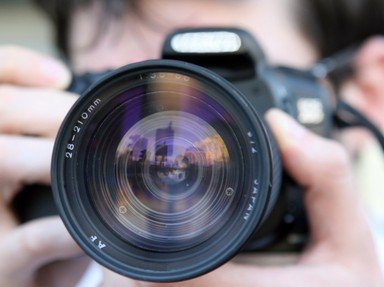Quiz Answer Key and Fun Facts
1. In the 1830s Louis Daguerre invented the first practical method of making permanent photographic images using iodine-coated silver plates on which sunlight produced an image. How long could you expect to be required to sit still if you were having your picture taken this way?
2. In 1841, Henry Fox Talbot patented a two-step process in which the negative image produced when a piece of paper coated with a silver halide was exposed to light; this paper was then used to produce a second image in which light and dark were again reversed, giving a positive image. What name, from the Greek for a beautiful picture, did he give to his process?
3. During the 1850s, a number of techniques were developed that produced a positive image directly on a solid surface. Which of these is NOT the name for a process that might have been used to give you a positive image photograph of yourself on a metal surface that had been specially coated?
4. The impulse photograph became even more popular in the 1870s, when Richard Maddox developed a so-called dry plate process, using a gelatin emulsion on a glass plate to produce a negative with much shorter exposure times required than any earlier processes. It was so fast that a hand-held camera, rather than one fixed to a frame or mounted on a tripod, became a real possibility. Then followed the marketing of the home camera, designed to that everyone could take photographs for themselves, although the developing process was still left to professionals. Who patented the Kodak camera in 1888, and allowed you to take your own pictures of your nearest and dearest with a box camera?
5. What innovation did the autochrome plate, patented by the Lumiere brothers in 1903 and marketed from 1907, allow you to have in your portrait?
6. In 1947 Edwin Herbert Land developed a process that allowed you to see the print of your photograph within one minute of having it taken. What company, which he had helped establish, first gave the public instant photographic gratification?
7. In 1963 Kodak introduced a point-and-shoot camera with film in an easily-loaded cartridge that allowed photographers who hadn't mastered the complexities of light meters, f-stops, shutter speeds, focusing and the other technical aspects of photography with a high-quality SLR camera to take workable photos with a minimum of fuss. Even the box camera required some dexterity in getting the film loaded. This Kodak model was so popular that many used its name as the generic name for this type of camera. What was it called?
8. One of the attractions of studio portraits was the fact that the professional photographer could use various processes to manipulate the image so as to make you look more attractive. In 1990, Adobe released a computer program that allowed you to manipulate your own images, assuming you could get them into a digital format. What was the name of this program?
9. Digital cameras had been on sale since the late 1980s, but were only released to the consumer market in the mid-1990s. They became popular at least in part because you could see your picture immediately, and delete it if you did not like it - no need to wait to have it developed before you knew how well it had worked. Which of these was NOT a digital camera released between 1995 and 1996?
10. The stand-alone digital camera is no longer the most commonly-used camera for taking pictures - that honor goes to the smartphone. What is the word used to describe a picture you take of yourself, and post on the internet to share it?
Source: Author
looney_tunes
This quiz was reviewed by FunTrivia editor
ozzz2002 before going online.
Any errors found in FunTrivia content are routinely corrected through our feedback system.

